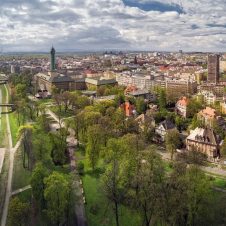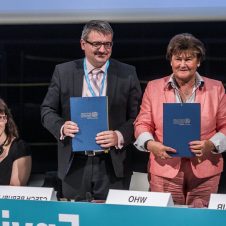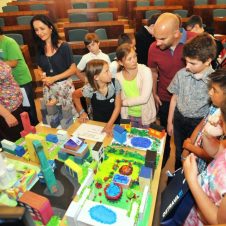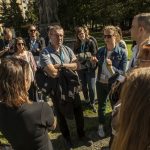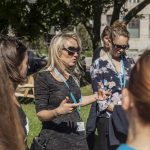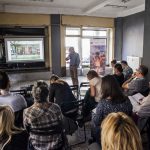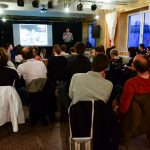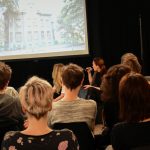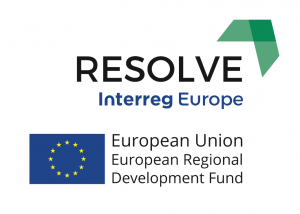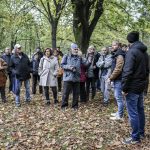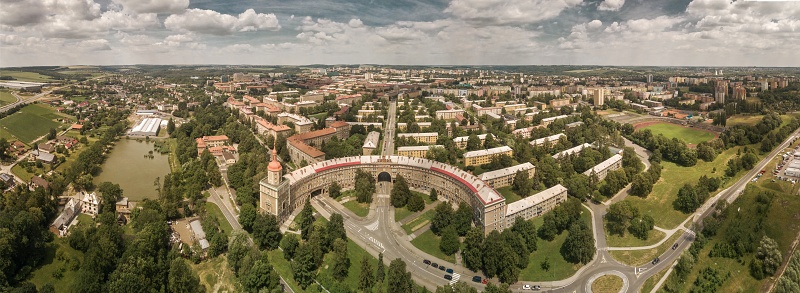Thematic articles
Projects
-
The Smart City project
-
Covenant of Mayors
-
Refill project
-
Resolve project
-
Environmental management
-
Public involvement projects
-
Participative budgets
-
Healthy Cities programme
The Smart City project

The City of Ostrava is a member of a strategic partnership supporting the application of smart technologies in five thematic areas outlined within the Smart Region Development Strategy, approved by the Moravian-Silesian Region in June 2017. The Czech Ministry of Regional Development recognized the excellence of this Strategy by awarding it the highest possible status in the country’s regional smart concept system.
One of the five priority thematic areas of the Strategy is ‘Savings’, which focuses on supporting projects introducing smart measurement systems in buildings, modernizing buildings to use renewable energy resources, mapping air quality by sensors in the internet of things, supporting the circular economy and smart waste management, and providing environmental education. In 2017, in partnership with the Moravian-Silesian Region, the City supported a public competition to find eco-innovations which help to achieve energy savings. In 2018 two of the winning projects will apply the solutions in the fields of zero waste management and air quality monitoring.
In April 2017 Ostrava organized a conference of the Visegrad V4+ countries (the Visegrad 4 plus Romania and Bulgaria) to discuss the Smart Cities concept in the context of the V4+ countries – with the participation of experts from other European countries. One of the topics of discussion was the use of EU structural funds and other forms of funding for the development of Smart Cities. The round table discussion featured around 40 representatives of public administration from the V4+ countries, and the conference as a whole was attended by approx. 150 delegates – mostly representatives of cities and experts on the issues discussed.
Covenant of Mayors

The City is also a member of the Covenant of Mayors and the ‘Mayors Adapt’ initiative. As part of this initiative, in 2013 Ostrava drew up its SEAP, and it has recently completed its SECAP – incorporating both mitigation and adaptation measures.
More information about the initiative here.
Refill project

As part of URBACT, Ostrava has become a partner in the REFILL project; its aim is to find temporary uses for vacant spaces (unused, abandoned, derelict land and buildings) and to establish such forms of temporary use as a standard practice. The project is part-financed by URBACT III (85%) and partly by the City (15%). Ostrava’s partners in the project are nine other European cities; the project is implemented on an international level via experience-sharing among the partner cities, and on a local level by local working groups. The City has the role of decision-maker (it sets the conditions for temporary use of the premises). The owners of the sites determine the function of the site and the duration of the temporary use, and the users comply with the conditions set by the City and the owner and invest in the development of the sites.
[art_yt id=”Q9g0jzdBrDM” wvideo=”640″ hvideo=”360″ position=”center” urlvideo=”https://youtu.be/Q9g0jzdBrDM” namevideo=”” desc=”” durationmin=”” durationsec=”” upld=”” tmburl=”https://i.ytimg.com/vi/Ogk1RAO-Z6w/maxresdefault.jpg” thumbnailwidth=”1280″ thumbnailheight=”720″]
Resolve project

Ostrava is also involved in the international project ‘Resolve’, which brings together European cities (from countries including Sweden, the Netherlands and Slovenia) to share experience on implementing sustainable mobility. The aim of the project is to improve air quality/reduce carbon emisssions created by retail related traffic by making public transport more attractive and accessible and creating a safe environment for cyclists and pedestrians. The project (co-financed via the INTERREG programme) will be implemented up to 2021.
[art_yt id=”S0NXoDqvtRc” wvideo=”640″ hvideo=”360″ position=”center” urlvideo=”https://www.youtube.com/watch?v=S0NXoDqvtRc&feature=youtu.be” namevideo=”” desc=”” durationmin=”” durationsec=”” upld=”” tmburl=”https://i.ytimg.com/vi/Ogk1RAO-Z6w/maxresdefault.jpg” thumbnailwidth=”1280″ thumbnailheight=”720″]
More information about the project here.
Environmental management

Environmental management is represented by Ostrava’s implementation of ISO 14000 standards at the City Authority building; this is directly connected with the City’s integrated management system, as part of which the City also plans to introduce ISO 5000 standards in order to gain certification for a fully integrated energy management system. Currently the City is also preparing to introduce an Environmental Management and Audit Scheme (EMAS) at the City Authority.
Public involvement projects

The City involves members of the public in urban development via a range of public debates, happenings, exhibitions, engagement activities and specific programmes.
The grant programme ‘Revitalization of Public Spaces in Ostrava’ aims to encourage the gradual revitalization and aesthetic improvement of public spaces that are currently non-functional or unaesthetic; the key principle is to involve members of the general public in the process of improving quality of life and creating public spaces. It was was published by the city in January. Sixteen project applications were submitted, out of which 11 succeeded and were financially supported.
One of these is the restoration of statues in the Milady Horákové orchard. These four, valued statues were sculpted during the International Symposium of Spatial Forms, held in Ostrava in 1967 and 1969. The city of Ostrava provided this project with 99,000 Czech koruna for the restoration.
Participative budgets

Three large municipal districts (Ostrava-Jih, Marianské Hory, Poruba) have introduced participative budgets, and there are plans to introduce a similar system at City level.
Healthy Cities programme

For some time now the municipal district of Poruba has met the criteria for the international Healthy Cities programme and Local Agenda 21 (LA21); currently it is attempting to move up to category C of LA21 within the rules of the Czech National Association of Healthy Cities.
The involvement of one of Ostrava’s largest municipal districts in the Healthy Cities programme and LA21 can be seen as a form of piloting, laying the foundations for the entire City of Ostrava to become involved. This approach was selected because it is well known that it is difficult for large cities in their entirety to successfully become involved in Healthy Cities and LA21 (Prague too is involved primarily via its individual municipal districts). This process was discussed and confirmed at a meeting between City representatives and the Director of the Czech National Association of Healthy Cities held as part of the WHO conference in Ostrava in June 2017.
Fact sheets
Covenant of Mayors

An EU initiative focusing on local and regional government bodies voluntarily committing to improve energy efficiency and monitoring and to actively reduce greenhouse gas emissions within their own territory. Ostrava joined the Covenant of Mayors in November 2011.
Smart City/Smart Region

An EU-supported concept for sustainable development in cities and regions, and a powerful tool for achieving environmental improvements in the Czech Republic – including access to targeted funding. In July 2015 a joint declaration committing to the concept was signed by the City of Ostrava, the Moravian-Silesian Region, and two Czech ministries (Environment, Industry and Trade).
Environmental Management System

Ostrava’s City Authority launched its Environmental Management System (EMS) in November 2015. The system enables a sustained reduction of environmental impacts in the City’s management of its buildings, vehicle fleet and operations.
Strategic Plan
![]()
In 2016, over 20 000 people were actively involved in the creation of the City of Ostrava’s Strategic Plan for the period 2017–2023 – including experts, well-known figures and numerous citizens.
Strategic Plan
![]()
During 2016 people added over 47 000 data entries, comments and ideas to Ostrava’s Feeling Maps. Many of these contributions concerned environmental issues, and the City took them into account when creating its Strategic Plan.
A Healthy City
![]()
One of the three priorities of the City of Ostrava’s Strategic Plan. The priority incorporates two strategic goals – cultivating Ostrava’s public space for all generations and bringing the city closer to nature.
Air Tritia

An international project featuring selected partners from the Czech Republic, Slovakia and Poland focusing on air quality in the tri-border region. The main aim of the Air Tritia project is to create an effective international air quality management system.
Children’s Fund

In 2010 the City of Ostrava set up a fund to help children at risk due to air pollution. The fund is used to pay for organized vacations in healthy environments for children living in Ostrava.
Grass-roots projects

The number of grass-roots projects for the revitalization of public spaces submitted by members of the public and approved for implementation (2016).



